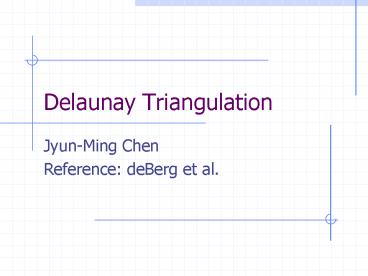Delaunay Triangulation - PowerPoint PPT Presentation
1 / 43
Title:
Delaunay Triangulation
Description:
This is also called the Bowyer-Watson algorithm. Fall 2005. 14. Boywer-Watson Algorithm. Bowyer-Watson triangulation: circum-circles that contain the new point, ... – PowerPoint PPT presentation
Number of Views:212
Avg rating:3.0/5.0
Title: Delaunay Triangulation
1
Delaunay Triangulation
- Jyun-Ming Chen
- Reference deBerg et al.
2
Important Concepts
- Angle vector of T sorted internal angles
- Angle-optimal triangulation T A(T) ? A(T) for
all triangulations T of P
3
Important Concepts
- Illegal edge, edge-flip and angle-vector
- Legality test
The correctness of this criterion follows from
Thales theorem
4
Proof
- We need to show that angle vector gets bigger if
illegal edge is flipped - There are six angles in current configuration
- ?pqr ?psr gt 180 are the larger onesthe rest
four are the smaller ones - Need to show that once flipped, all six new
angles are larger than the four old smaller ones - The ordering of angle vector is determined by
smallest angle
5
q
r
p
s
6
q
r
p
s
7
Algorithm
- Only flip if ijkl are convex (non-convex cannot
flip) - It will terminate
- Too slow to be interesting
- How to come up with initial triangulation T ?!
8
Incremental Algorithm
This was first suggested by Lawson(77)
9
Recursive Call
Complication on presence of p-1, p-2, p-3
10
Swap Test (Text, exercise 9.5)
Note the triangle ?pqr is CCW!
11
Swap Test (TRIPACK, Renka96)
For numerical robustness (next page) Swap if
sin12 ? - swtol
Just check the sign!!
12
Numerical Robustness
2
cocircular
Almost cocircular
3
4
1
do not flip avoid cycling
4
Dont flip
flip
1
13
Observation
- Every new edge created due to insertion of pr is
incident to pr
This is also called the Bowyer-Watson algorithm
14
Boywer-Watson Algorithm
Bowyer-Watson triangulation circum-circles that
contain the new point, and the resulting
triangulation
15
(No Transcript)
16
- Create DT(P)
- Mark center of circum-circle carefully
- Do the in-circle test by comparing distances
- Perform all necessary LegalizeEdge steps
-1
(i)
(i)
-2
(i)
-3
17
-1
(0)
(i)
(iv)
-2
-3
18
-1
(0)
(iv)
(iv)
-2
-3
19
-1
(iii)
(0)
(i)
-2
-3
20
-1
(ii)
(0)
-2
-3
21
-1
(0)
(i)
(iii)
-2
-3
22
-1
(ii)
(iii)
-2
-3
23
-1
(0)
(0)
-2
-3
24
-1
-2
-3
25
(No Transcript)
26
(No Transcript)
27
(No Transcript)
28
(No Transcript)
29
(No Transcript)
30
(No Transcript)
31
(No Transcript)
32
Edge swap complexity!?
33
(No Transcript)
34
(No Transcript)
35
Choosing Initial Triangle
- far away so that they dont influence the DT of P
- Dont want to introduce huge coordinate
(numerical errors)
36
The Choice Suggested by Text
- Choose them to contain P
- Modify illegal edge test whenever p-i are
involved - p-1 is outside any circles defined by P
- p-2 is outside any circles defined by P?p-1
- p-3 is outside any circles defined by P?p-1,p-2
37
Case Analysis Is pipj legal?
- 0 Polygon concave legal
- i Both ij negative legal
- ii i,j,k,l positive normal case
- iii Exactly one of (i,j,k,l) negative choose
the one with positive as legal - ivExactly two of (i,j,k,l) negatives choose
the one with smaller negative as legal - v Exactly three of (i,j,k,l) negatives cannot
occur
38
Logical Analysis
i,j,k,l
ilt0 ? jlt0
NOT( ilt0 ? jlt0)
i,j,k,l two negative i?j must be one negative
i,j,k,l all positive
i,j,k,l one negative
i,j,k,l three negative impossible
39
Point-Location Subproblem
- To locate the triangle containing pr
- Data structure D as described in text
40
Alternate Point-Location Test
Abstract of Mucke et al. 96
41
Explanation from Kallmann et al.03
42
Example
p
43
AP EMST (exercise 9.11)
- Q(n2) edges, standard MST algorithm O(n2)
- EMST ? DG
- O(nlogn) algorithm to compute EMST for P
- TSP































